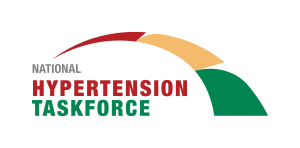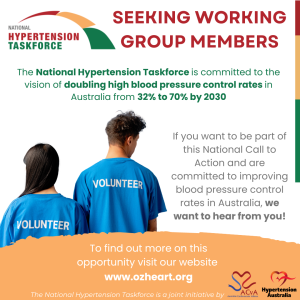Hypertension in Australia
High blood pressure (hypertension) is the leading risk factor for death in Australia and globally. In Australia, raised blood pressure is responsible for 43% of coronary heart disease, 41% of stroke, 38% of chronic kidney disease and 32% of atrial fibrillation and flutter. Blood pressure control rates in Australia are lagging those of other comparable countries. Alarmingly, one in three adults in Australia has hypertension, but only half of these people know they have it. High blood pressure can be controlled through a healthy lifestyle and effective medication, however, in Australia only 32% of those with hypertension have it under control.
The National Hypertension Taskforce of Australia
In response to a national call to action to improve blood pressure control rates in Australia,1 a National Hypertension Taskforce was established2 with a remit to double high blood pressure control rates in Australia from 32% to 70% by 2030. The Taskforce has membership across the health spectrum including peak bodies, professional societies, clinicians, researchers and consumers with lived experience.
The National Hypertension Taskforce is a joint initiative of Hypertension Australia (HA) and the Australian Cardiovascular Alliance (ACvA) and is a priority identified as part of the ACvA’s Clinical Themes Initiative.
Key Priority Areas
The Taskforce has identified the following five key priority areas that will be critical on the path to achieving better blood pressure (BP) control for all Australians. To address these priority areas, the following five working groups will be established.
- Developing up-to-date, simple BP management tools for healthcare providers. This would include brief, user-friendly, easy to access guidance on relevant aspects critical for adequate BP management such as accurate clinic BP measurement, use of out-of-office BP measurement, up-titration of antihypertensive medication, preferred use of single pill combination therapy, and others with reference to existing Health Pathways where feasible.
- Increasing patient activation and engagement. Within this broad space, elements such as improving health literacy, activities to improve how people already diagnosed with hypertension can be ‘activated’ to improve their own health, and others should be addressed.
- Raising and maintaining awareness at all levels. This includes raising awareness on the importance of BP for cardiovascular health in general, its accurate measurement and management, among the community (consumers: “Know your numbers”), healthcare providers, government, and any other stakeholders.
- Establishing a systems and data-based approach to BP management. It is important to setup processes to ensure integration of BP data across the health sector, with all healthcare providers having access to electronic health records, identifying high risk patients, and to optimally use data for population monitoring and evaluation, to inform practice and team-based care.
- Improving detection (screening) of people with elevated BP to identify those at risk. This could include community-based screening, but also access through healthcare providers such as nurses and pharmacists, as well as opportunistic screening initiatives such as those of the Stroke Foundation and May Measure Month potentially joining forces.
All priorities will have specific emphasis on First Nations peoples, culturally and linguistically diverse (CALD) populations as well as Australians from rural, regional and remote communities.
Health economic analyses and continuous engagement with government will be foundational elements required to address the Key Priority Areas.
We are seeking expressions of interests to join the Hypertension Taskforce Working Groups
Our ideal candidates are:
- committed to being ambassadors for the Taskforce and its vision.
- demonstrating a proven track record and expertise in the areas related to the focus areas of the relevant Working Group.
- willing and able to dedicate time to contribute and/or lead working group meetings and to perform delegated tasks and contribute to the overall strategy and vision of the Taskforce.
- experienced in working as part of a multi-disciplinary, regionally dispersed team.
As a member of a working group, you will work closely with members of the Taskforce and Steering Committee to develop a strategic roadmap and plan of action for the Working Groups.
Please note that being a Working Group member is a non-salaried honorary appointment.
How to apply
Please provide a cover letter and two-page CV that best demonstrate your motivation, commitment and ability to meet the requirements of this role. In your cover letter please indicate the Working Group you would like to join, and if you are interested in a leadership role.
All applications should be submitted to acva@ozheart.org by COB Friday 10 June 2023.
For further information please contact Co-Chairs of the Hypertension Taskforce:
Professor Alta Schutte a.schutte@unsw.edu.au, and
Professor Markus Schlaich markus.schlaich@uwa.edu.au
References
- Schutte AE, Jennings G, Schlaich M. Uncontrolled blood pressure in Australia: a call to action. Med J Aust. 2022;216:488. doi: 10.5694/mja2.51498
- Minister Butler Launch the National Hypertension Taskforce. In; 2022:https://publish.viostream.com/play/bfxgwogds4j9ni.
